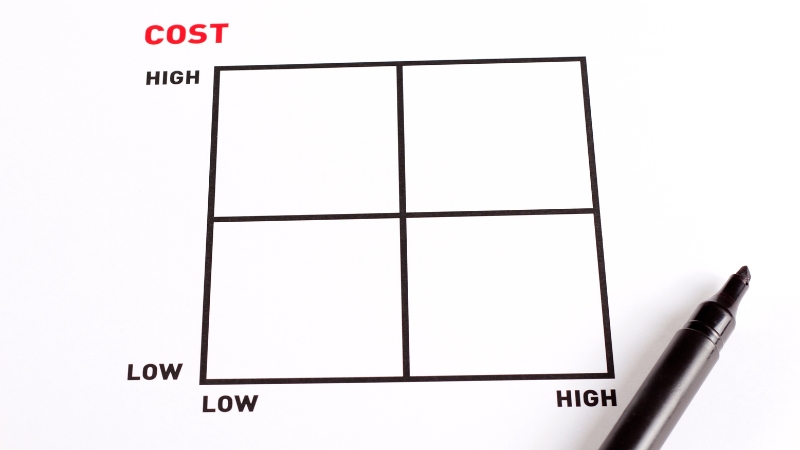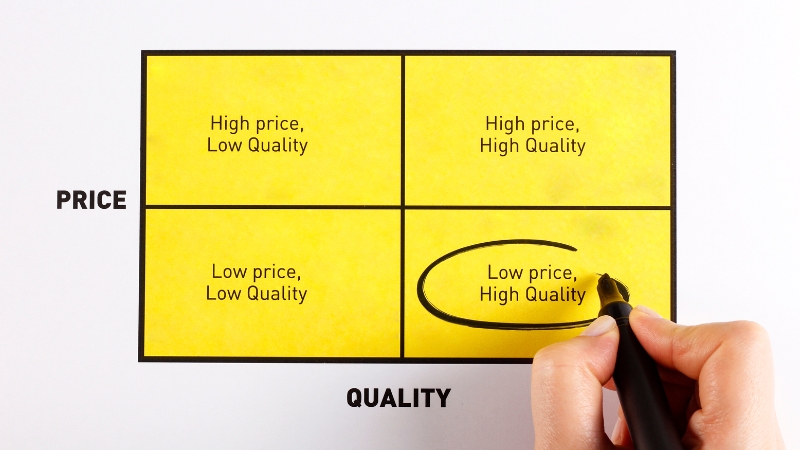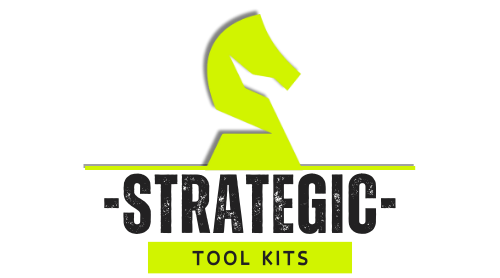If you’ve ever looked at a product catalog and wondered how these things are organized, why some brands have multiple versions, tiers, add-ons, bundles, or variant lines, you’re looking at decisions rooted in a product matrix strategy.
This tool helps businesses systematically decide which products or variants to offer, how they relate, and why customers might move or “upgrade” between them.
In simpler terms, a product matrix is a structured way to map out your product lines and their variations across dimensions (such as features, price, customer segments, use cases).
A product matrix strategy is how you use that map to grow revenue, manage complexity, optimize margins, and guide your customers along a product “journey.”
What Is a Product Matrix?

A product matrix is a structured way of visualizing your entire product lineup. It helps you see which products you offer, how they relate, and which customers they serve.
Typically, it’s built like a grid:
Rows
Columns
Example
Product lines or customer segments
Product variations, features, or price tiers
“Basic / Pro / Enterprise” plan across customer types
Each cell in the matrix represents a specific product version, like iPhone 16 Pro, Netflix Premium, or Toyota Corolla Hybrid.
In short, it’s the map of your offerings showing gaps, overlaps, and growth opportunities all in one place.
Why a Product Matrix Strategy Matters
A product matrix isn’t just a visual chart; it’s a strategic tool.
It ensures your products fit the market, your pricing captures different levels of demand, and your roadmap grows logically instead of randomly.
Key Benefits
Benefit
What It Means
Example
Segmented Pricing
Offer different tiers for different budgets
Adobe’s “Individual,” “Team,” and “Enterprise” plans
Customer Journey Design
Build clear upgrade paths
A user moves from Netflix Basic → Standard → Premium
Gap Detection
Identify missing products or features
A brand spots missing mid-range laptops
Portfolio Control
Avoid internal competition or over-complexity
Toyota limits trims to keep production efficient
Market Expansion
Enter new niches by adding matrix “cells”
A SaaS adds a “Freelancer” tier to attract solos
In essence, a product matrix balances choice and focus. It gives customers just enough options to feel in control, but not so many that they get confused.
Real-World Examples of Product Matrix Strategy

1. Apple: Clear Segmentation, Simple Choices
Apple’s product lineup is built on a perfect matrix.
Line
Base Model
Mid-Tier
High-End
iPhone
iPhone 16
iPhone 16 Plus
iPhone 16 Pro / Pro Max
MacBook
MacBook Air
MacBook Pro (M3)
MacBook Pro (M3 Max)
iPad
iPad
iPad Air
iPad Pro
Apple’s structure guides customers smoothly from entry-level to premium without overwhelming them, while maintaining strong profit margins at every level.
2. SaaS Companies: The Power of Tiers
Software-as-a-Service businesses live and breathe the product matrix model.
They organize plans by user type (individual, team, enterprise) and feature access (basic, pro, advanced).
Customer Segment
Basic Plan
Pro Plan
Enterprise Plan
Individual
Core tools
Premium features
,
Team
Shared access
Advanced collaboration
Custom integrations
Enterprise
,
,
Scalable deployment, security suite
Think of Slack, HubSpot, or Asana; their pricing pages are literally product matrices. They turn complex software into simple upgrade paths.
3. Automotive: Trims and Variants

Car manufacturers rely heavily on matrix planning.
Each model (row) offers multiple trims or configurations (columns):
Model
Base Trim
Sport Trim
Hybrid / Electric Trim
Corolla
L
SE
Hybrid
Camry
LE
XSE
Hybrid
RAV4
LE
Adventure
Prime Plug-In
The matrix also makes upselling natural, customers move up trims for more power or comfort.
4. Consumer Goods: Coca-Cola’s Product Grid
Even beverage companies use product matrices.
Flavor Line
Standard
Diet / Zero Sugar
Variant
Cola
Coca-Cola Classic
Coca-Cola Zero
Cherry Coke
Fanta
Fanta Orange
Fanta Zero
Fanta Grape
Sprite
Sprite Original
Sprite Zero
Sprite Lemon-Lime+
Each combination serves a unique preference or market, from calorie-conscious consumers to regional flavor fans.
How to Build and Apply a Product Matrix Strategy
View this post on Instagram
Designing your own product matrix doesn’t require massive resources, just clarity and structure.
Here’s how to do it in five practical steps.
Step 1: Define the Two Key Dimensions
Choose what your rows and columns will represent.
Common examples include:
Row (X-Axis)
Column (Y-Axis)
Customer segments
Feature tiers
Product categories
Price levels
Use cases
Market regions
Brand lines
Technology/performance
Make sure both dimensions are meaningful and connected to your strategy.
Step 2: Fill In the Grid, But Selectively
Now, sketch the full set of possible combinations.
Then filter so that every cell needs to exist. Offer only variants that make commercial sense.
Segment
Basic
Pro
Premium
Student
✔️
,
,
Professional
✔️
✔️
,
Business
,
✔️
✔️
Fewer cells can often mean clearer positioning and higher profitability.
Step 3: Add Data, Price, Cost, and Demand

Assign estimated metrics to each product variant.
Variant
Price
Cost
Gross Margin
Expected Demand
Student Basic
$9
$3
67%
High
Professional Pro
$29
$8
72%
Medium
Business Premium
$99
$30
70%
Moderate
This step shows where you make money and where you might overextend.
Step 4: Define Customer Movement Paths
One of the biggest advantages of a product matrix is understanding how customers can “move” between cells.
- Start small → Upgrade over time
- Add modules or features horizontally
- Shift to a higher plan vertically
Mapping these journeys helps create targeted upgrade campaigns and lifetime value growth.
Step 5: Review, Monitor, and Adapt
Your matrix isn’t static. Market needs evolve, costs shift, and competitors launch new offerings.
Revisit your product grid every 6–12 months to ask:
- Are we missing any major customer segment?
- Are some variants too similar (causing cannibalization)?
- Which cells perform best and which drain resources?
Data turns your product matrix from a planning tool into a strategic dashboard.
Key Metrics to Track
Metric
Why It Matters
Unit sales per variant
Reveals product traction
Margin per cell
Ensures profitability balance
Upgrade conversion rate
Measures upsell success
Cannibalization rate
Detects overlap between variants
Customer satisfaction per tier
Guides which cells to refine or retire
Tracking these KPIs ensures your matrix stays profitable and aligned with customer behavior.
Common Pitfalls to Avoid
@paulineescobibo Lets discuss the ANSOFF Matrix!!! Another marketing strategy 😍 #learnontiktok #edutokph #edukasyonph #marketing ♬ original sound – Pau Escobedo
While powerful, a product matrix can go wrong if not managed carefully.
- Too many options: Confuses customers and complicates production.
- Overlapping tiers: Causes cannibalization, one variant steals sales from another.
- Unclear differences: Customers can’t see value gaps between plans.
- Neglecting updates: The matrix becomes outdated as the market shifts.
- Data blindness: Decisions made on assumptions instead of real numbers.
A good matrix is simple, current, and data-informed, not just a long list of SKUs.
The Takeaway
A product matrix strategy gives structure to your creativity. It allows you to innovate without chaos, expand without confusion, and serve multiple customer types with clarity.
By mapping your offerings, pricing, and segments in one visual framework, you can:
In short, your product matrix is the blueprint of your business growth, clear, flexible, and grounded in real customer behavior.

